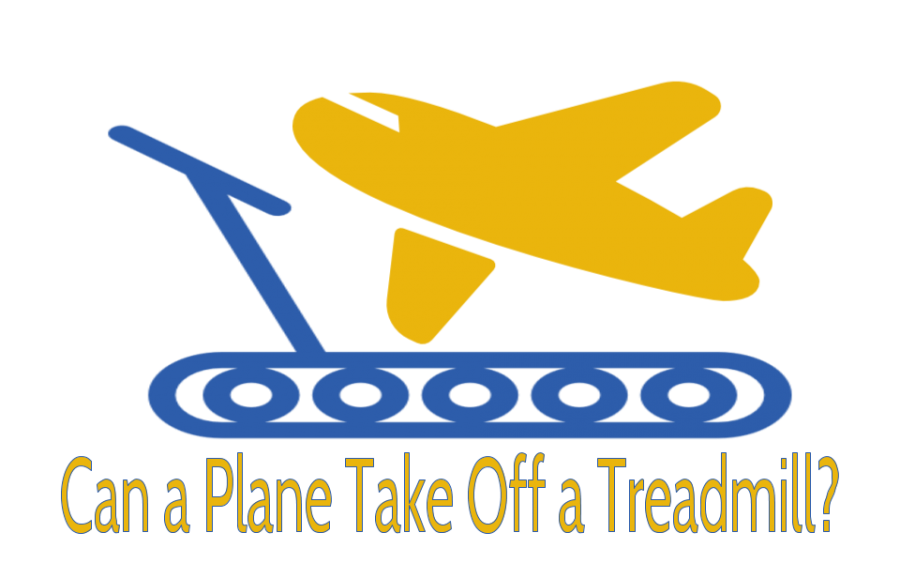The Most Trivial of Pursuits: Can An Airplane Take Off of A Treadmill?
November 7, 2018
The modern airplane is an ingenious machine. The idea that a multi-ton piece of metal can fly through 30,000 feet in the sky at speeds of over 500 miles per hour would baffle the mind of anyone born before 1800 (besides maybe Leonardo Da Vinci). But we’re living in the 21st century, and airplanes roar overhead everyday.
What matters now is how creatively an airplane can take off.
Usually an airplane at an airport starts at the end of a runway, picks up speed, then takes off into the sky. The question is, how far does an airplane need to travel to take off? Specifically, can an airplane take off a treadmill?
Let’s set some parameters for this hypothetical situation. The airplane we’re dealing with is a standard Boeing 737. It is a sunny day with a light breeze, and the treadmill we’re using is twice as long and just as wide as the aircraft.
Will the plane be able to take off?
It Will: Gavin Meyer
The airplane will take off like a normal plane. The wheels don’t matter, it’s the propellers [jet engines] that get the plane moving. The wheels are basically frictionless. It’ll just take off like a normal plane. It will fly off like a normal plane from a normal runway.
It Will Not: Nathaniel Martin
Newton’s Third Law states that “for any action there is an equal opposite reaction.” Airplanes are designed to use this in order to take off. An airplane’s wing is built so that the wind is pushed below the wing, and the reaction of the wind being pushed down is the wing being pushed up into the air. This only works when air is moving around the plane. On a treadmill the plane may be traveling at hundreds of miles an hour, but it is still stuck in the same spot. The air around it is not moving. With no air movement, there is no lift, and with no lift, the plane cannot take off.








Steve • Mar 20, 2021 at 4:33 am
The problem here is that the question is a bit devious with how it interacts with our brains.
The correct answer, for all practical purposes, is that yes, the plane will take off. But thinking that it won’t is utterly understandable on a few different levels.
Planes are vehicles that sit on wheels with people inside and move forward, when on the runway before takeoff. Because of this, people tend to associate a plane taxiing on a runway with a car. I’d imagine 99.999% of people encounter cars far more frequently than they encounter planes, and so when they encounter this question, their intuition goes to how a car would behave in this situation, and indeed if you put a car on a treadmill that matches the rotation speed of the drive wheels, the car will never move forward, it will just sit there.
The problem with applying this to planes is in the details of each machine’s mode of propulsion: a car moves by exploiting friction between the tires and the ground. By exerting a force between the wheels and the ground, either the car or ground has to move, and in the treadmill model the strip of ground beneath the car moves easier than the car. For a more real-life example, a car getting stuck in the mud happens in part because the wet ground is less cohesive than usual so when force is applied it all goes towards flinging loose ground out from under the car.
But planes don’t work that way; their engines propel them by pushing against the air around them. If you want to think about this using a car, imagine a car sitting in neutral on a treadmill that is then pushed along by a wall that moves against the direction of the treadmill, and pushes the car. What happens in that scenario? The car’s wheels spin faster than they otherwise would, and this brings us to the second level of confusion.
There are people who get this and think that even if that is all true, if the treadmill matches the rotational velocity of the wheels then the plane shouldn’t move. The problem with this is that unlike with a car, the wheels don’t directly impart their speed to the plane. They exist mainly to eliminate as much friction from the ground as possible to allow similar power outputs to give the plane forward thrust with it both landed and airborne. There is still some friction at rest but once the wheels are rolling it becomes very negligible in the system.
The problem we run into is that eventually this setup would produce a treadmill that trended to light speed and beyond to keep the plane stationary. If you have a power source that can run that indefinitely, it will work to stop the plane from moving since you can impart infinite force in response to any finite force working to keep the plane grounded (though honestly if you have that, you should probably use that to fix the whole entropy problem). This setup also assumes things like indestructible tires and track, and perfect friction between wheel/tire and treadmill in that it assumes that if the wheel has a specific rotational velocity that it must be indicative of how fast the vehicle the wheels are on on is moving, but even in the world of cars this isn’t a given if you have ever done a burnout or skidded in adverse weather; the wheels spin either faster or slower than the car goes and results in a lot of panic in most cases of you didn’t do it on purpose.
Because of this, in theory you can think of a setup in which keeps the plane stationary using only a treadmill and the plane’s wheels, but applying any realistic restrictions on the speed of the treadmill causes the plane to take off despite the treadmill